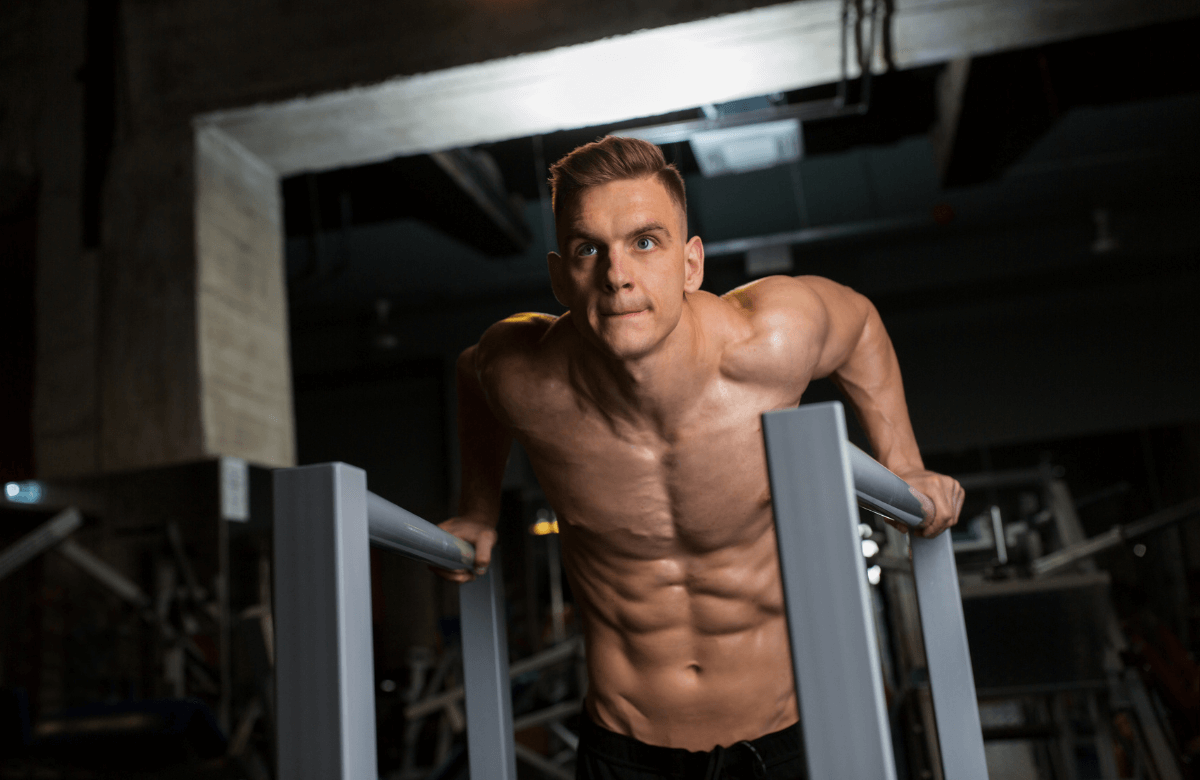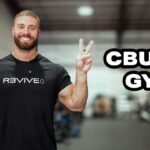In this article I’ll cover the 10 most powerful lateral head tricep exercises:
- Cable pressdown
- EZ bar skull crushers
- Close grip bench press
- Diamond push-ups
- Weighted dips
- Overhead triceps extension
- Dumbbell french press
- Cable kickbacks
- JM press
- Bench dips
On top of that, you’ll learn about the triceps anatomy & function, the location of the lateral head, whether you can isolate it or not, and the benefits of the lateral head tricep exercises.
Make sure to read all the way through to find the perfect workout to take your triceps growth to the next level. Let’s jump right into it!
Jump to:
Triceps Anatomy & Function
The triceps brachii is a three-headed muscle composed by:
– Medial head
– Long head
– Lateral head
All tricep heads are on the back of the arm, often resembling a “horseshoe.” (1).
Although each head has a different tendon origin, they all insert in the olecranon process (the bony prominence of the elbow) located on the upper portion of the ulna (2).
The primary function of the triceps brachii is to extend the forearm at the elbow joint. On top of that, it also stabilizes the shoulder joint when doing fine movements such as writing (3)
Where Is The Lateral Head Of The Tricep Located?
The lateral head of the tricep is located on the outside of the arm. This single head represents a big part of your triceps size.
The medial and long heads are on the inside of your arm, and all three are responsible for giving the arm a rounded look.

Can You Isolate The Lateral Head Of The Tricep?
Although you can bias the lateral head of the tricep, it’s impossible to isolate it fully. You can’t isolate any muscle since the body works as a whole for every movement.
However, that doesn’t mean there aren’t ways to efficiently target one section of the muscle more than the other. For that to happen, there must be adjustments in the grip, angle, and equipment (barbell, dumbbell, kettlebell, etc.)
Benefits of Lateral Head Triceps Exercises
The lateral head is the most significant portion of the three heads. Having solid and muscular triceps is beneficial not only for strength but also for aesthetic reasons.
Since the triceps play a crucial role in most pressing movements (bench press, overhead press, push-ups, etc.), including lateral head tricep exercises in your workouts and triceps routine is vital.
Once you begin doing them, you’ll notice a significant improvement in all of your pressing exercises, not to mention that your arms will catch the attention of those around you.
How To Target The Lateral Head Tricep
Lateral head tricep exercises are the perfect way to target this particular head of the triceps brachii. Below are ten effective exercises you can do in your next workout session.
1. Triceps Cable Pressdown
The cable press-down is one of the most popular exercises for the triceps. It’s easy to set up and doesn’t require any experience. If you have a cable machine with a handle, you should always keep this exercise in the mix.
How To Do It
- Attach the straight bar handle to the cable.
- Set up the preferred weight.
- Stand in front of it and hold the handle with one hand on each side.
- Feet at shoulder-width (or staggered stance) and elbows slightly away from the body.
- Press down, keeping your wrists neutral and your torso upright until your elbows are fully locked.
- Go back to the initial position, and that’s one rep.
Pros
- You can do a lot of volume. Since this exercise doesn’t tax the body systemically, it recovers faster. This means you can train harder and more often, and they’ll recover faster than other large groups (quadriceps, glutes, etc.)
- Easy to set up. You only need a cable machine and a straight bar attachment to set up this exercise, and you’re ready to go.
- The triceps pushdown is simple because it only requires you to hold the bar, extend your elbows, and bring it back to 90 degrees in front of your body. That’s why it’s a favorite among beginners. Ideal for beginners.
Cons
- It requires a cable machine. Cable machines are expensive. However, most gyms have one, but not all of them do, which could limit the number of times you do the exercise.
- You need a lot of volume. The pushdown needs several sets and reps to make your triceps fatigued. This is not a bad thing; it’s just inconvenient for people who need to work out faster.
2. EZ Bar Skull Crushers
Skull crushers are the go-to exercise for triceps growth among many lifters. It’s easy to do, and the pump you’ll feel afterwards is phenomenal.
How To Do It
- Set up the EZ Bar with the desired weight, and put safety clips on both sides.
- Lay your back down on the bench and make sure you’re stable and comfortable (feet flat on the ground, upper back and head on the bench)
- Grab the EZ Bar and hold it on top of you at eye level with the elbows fully locked.
- Slowly descend the bar until it reaches the back of your head, and your triceps are fully stretched.
- Keep your elbows from flaring out.
- Pause for 1-2 seconds at the bottom, then extend your elbows until they reach the initial position with the bar at eye level and elbows fully locked.
Pros
- The triceps are very responsive to skull crushers. It doesn’t matter if you’re an elite or advanced lifter. The EZ bar skull crushers will tire your triceps quickly.
- It may also work your grip. Part of the challenge of the exercise is gripping the bar hard enough so it won’t slip and change position throughout the range of motion. This action may work as a secondary grip workout.
Cons
- Puts more tension on the elbow joint compared to others. Due to the shoulder and elbow position during the movement, the skull crusher puts more pressure on the elbow tendon, which may feel uncomfortable for some people.
- It’s not ideal for beginners. Although the skull crusher is not the most demanding exercise, it can be challenging for beginners or inexperienced individuals. I’d suggest starting with a simpler variation, like the cable pushdown.
3. Close Grip Bench Press
The close grip bench press is an underrated exercise for targeting the lateral head of the triceps. Most people only associate the bench press with a regular chest workout, forgetting that by closing the grip a little more, they’ll get a terrific tricep pump.
How To Do It
- Set up a straight barbell on the rack.
- Lay down on the bench facing up and beneath the bar (the bar should be at eye level.)
- Grip the bar slightly narrower than shoulder width.
- Press up to unrack the bar and hold it at chest level with elbows fully locked and wrists neutral.
- Bring the bar down to your chest by flexing your elbows and keeping your arms slightly aside from your torso.
- Once at the bottom, push the bar back up by extending your elbows and keeping your wrists neutral. That’s one rep.
Pros
- You can lift heavy. Many lifters find themselves lifting more than 200 pounds for reps. Because the close grip press is much like the regular barbell bench press, the triceps are in a position that biases strength.
- Target your pecs and shoulders. Besides targeting the lateral head of the triceps, it also hits the front delts and the pec muscles, making it a compound movement more than an isolation exercise.
Cons
- Some people may feel elbow discomfort. Narrowing the grip on the bar means flexing your elbows more, which increases the tension at the tricep tendon. Although this is not inherently bad, some people may experience pain or discomfort.
4. Diamond Push-Ups
Diamond push-ups are one of the favorites among fitness enthusiasts. They’re practical, accessible (can do it anywhere), and effective. You can do them at the beginning, during, or end of your workout.
How To Do It
- Place both hands on the floor, making a diamond shape.
- Hold your entire body off the ground with only your hands and feet on the floor.
- Lock your elbows and make sure your back and hips remain neutral without dropping down.
- Flex your elbows and lower yourself until your pecs touch the ground.
- From here, extend your elbows until you return to the initial position while keeping your spine neutral.
Pros
- You can do it anywhere. One of the many advantages of diamond push-ups is how practical and accessible they are. It doesn’t require any equipment but your own body.
- It’s a compound movement. On top of making the lateral head of your tricep grow, it also works your pecs and front delts, which makes it a compound movement.
Cons
- It may be hard for beginners. People starting their fitness journey for the first time may find this movement hard to master. The reason is that they aren’t strong enough to control their own body.
- Women may struggle with it. On average, women have less upper body strength compared to men, which makes the diamond push-up even more complicated than it is. One variation women can try is the knee diamond push-up.
5. Weighted Dips
The weighted dips are a variation from the parallel dips. It’s the same movement pattern but with extra weight. You can add chains around your neck, a weighted vest, a belt attached to weights, or even a dumbbell between your legs.
How To Do It
- Find a stable parallel where you can perform the exercise.
- Set up the extra weight and ensure you can do multiple reps safely.
- Place one hand on each parallel arm and keep your wrists neutral.
- Push yourself up until your elbows are locked. Keep your feet together and chest upright.
- To begin the descent, bend your elbows and slightly lean forward to put your body in the ideal position for pressing up.
- Once your shoulders are at wrist level, begin pressing until you’re back to the starting position with your elbows locked.
Pros
- Works as a compound lift. Besides targeting the lateral head of your triceps, the weighted will also focus on developing the lower fibers of your pec muscles and your front delts.
- The triceps respond well to this exercise. You can notice the pump on your triceps after only one set. This means that the body positioning for this movement biases the triceps, which is good.
Cons
- Primarily for advanced lifters. Beginners should progress up until they’re comfortable without added weight first. The parallel dip is a challenging exercise, but adding extra weight makes it even harder for most people.
6. Overhead Tricep Extensions
The overhead tricep extension is a fantastic lateral triceps exercise. Although it also works the long and medial head, many people use it to bias the lateral triceps head.
How To Do It
- Pick a weight (dumbbell, kettlebell, etc.)
- Sit on a flat bench or a box. Keep the feet on the ground and the torso neutral (avoid hyperextending your spine)
- Hold the dumbbell with an overhand grip and bring it on top of your head with your elbows on full extension (this is your starting position)
- Slowly bend your elbows (below a 90-degree angle) and bring the weight close to the back of your neck.
- Extend your elbows as you bring the weight back to the starting position. That’s one rep.
Pros
- Isolates the triceps very well. Compared to other pressing movements, the overhead tricep extensions will isolate the muscle more than other exercises, creating more tension on every rep.
- Requires little equipment. You only need a dumbbell to do this lateral head triceps exercise. You could also do it with a kettlebell, bar, or cable. Regardless, the required equipment is minimum.
- You can use heavy weights. One of the reasons this exercise is so loved is that people feel comfortable using heavy weights, whether that’s dumbbells, kettlebells, bars, etc.
Cons
- Requires shoulder mobility. The proper form for this exercise requires enough shoulder flexion to get the elbows pointing overhead. Although it may seem easy for some people, it may be a limitation for others.
- Some people may feel discomfort on their shoulders. Since the shoulders need to go all the way up, some people may feel a little pain or discomfort on the head of the arm bone. It usually means they’re not ready for this movement and should modify it.
7. Dumbbell French Press
Dumbbell french press is a popular tricep exercise among lifters from all levels. It only requires a weight and elbow extension. You can do it at the beginning or the end of your arm workout, and your triceps muscles will be blasting.
How To Do It
- Set up a flat bench and make sure you’re stable on it.
- Pick a pair of dumbbells with your preferred weight.
- Lay down on your back with your feet on the ground, butt, upper back, and head on the bench.
- Bring the dumbbells up in front of you (eye level) with your elbows locked.
- Lower the dumbbells by bending your elbows until you reach maximal flexion.
- Push the dumbbells up by extending your elbows until they’re locked. That’s one rep.
Pros
- Easy to do. The dumbbell French press is simple to do. It doesn’t require any unique technique besides bending and extending your elbows. That makes it perfect for beginners and everyone starting their fitness journey.
- It has many variations. You can use a single dumbbell or a pair of dumbbells, bands, and kettlebells. All of them will target the lateral tricep head and push your triceps brachii muscle to grow.
- Great at isolating the triceps. This variation recruits the medial head of the triceps almost exclusively, which is crucial for building muscle mass.
Cons
- Some people may feel discomfort in the elbow joint. The arm position for this movement puts extra pressure on the triceps tendon, which may cause some pain among some lifters.
8. Tricep Cable Kickbacks
Cable kickbacks are one of the most common exercises you’ll find when you first step into the gym. It’s easy to do, and it only requires a cable machine.
How To Do It
- Set up the cable at the mid-thigh level. Attach a handle that allows you to grip the cable, or you can hold it by the head of the cable.
- Hold the cable and move away from the machine (3-4 steps).
- Keep the handle beside your mid-thigh and hinge your hips while leaning your torso forward.
- From that position, your elbow should be at 90 degrees flexion.
- Extend your elbow by pulling the cable back (like a kickback) until it reaches full extension.
- Keep your arm close to your body as you bring the handle back to 90 degrees.
Pros
- Beginner friendly. The tricep cable kickback is a precise movement that only requires hinging the hips and extending your elbows. It’s ideal for beginners or inexperienced lifters looking to work on the lateral head of the triceps without complications.
- Joint friendly. Compared to other exercises, the cable kickback doesn’t put any significant tension on joints or tendons close to the triceps, which makes it a terrific option for those struggling with nagging injuries relating to the elbow and shoulder joints.
Cons
- The range of motion is short. Although cable kickbacks are a terrific option for developing the lateral head of the triceps, it’s limited by the short range of motion (ROM), which means that the muscle stress is less compared to other exercises with a bigger ROM.
- The body is not stable. During the cable kickbacks, the body has no support where. It can feel stable and exert power. Therefore, watching lifters rack the weight up during this movement is uncommon.
9. Barbell JM Press
The barbell JM press is an advanced exercise for tricep development. However, it’s terrific for muscle growth. It’s a combination of a skull crusher and a close-grip bench press. This compound exercise will keep a constant tension on your tricep muscle.
How To Do It
- Set up the bar as you were to do a bench press.
- Lay back on the bench to the point where the bar is at eye level.
- Use an overhand grip and grab the bar with a close grip (just like a close-grip bench press)
- Ensure your feet, butt, upper back, and head are all in contact with the bench.
- Press the bar up until your elbows are locked (starting position)
- Bend your elbows and lower the bar until it reaches your neck (elbows should remain higher than your torso)
- Press up by extending your elbows until you’re back to the starting position.
Pros
- Compound movement. Besides targeting the lateral head of your tricep, this exercise also works your pec and front delts, making it a compound movement.
Cons
- Not ideal for beginners. The JM press requires strength and mobility on your shoulder and elbow joints, which beginners may initially lack.
10. Bench Dips
Bench dips are part of the tricep dips that target the lateral head of your triceps. This bodyweight exercise has been a part of everybody’s triceps workouts due to its practicality and easiness.
How To Do It
- Grab a bench, a chair, or a box. Whatever you have that can safely hold your weight.
- Sit close to the edge of it, and place your hands on the outside of your thighs, also close to the edge.
- Place your feet in front of you and bring them together.
- Push yourself up from the bench until your elbows are locked. Keep the chest upright.
- Slowly lower yourself by bending your elbows until your shoulders are close to the bench.
- Once at the bottom, extend your elbows until your body is back at the starting position with the elbows locked.
Pros
- Perfect for beginners, the elderly, and women. This is a terrific option for those who can’t do a full tricep dip on a parallel but still want to feel the stimuli of the dip movement pattern.
- You can do a lot of volume. This variation isolates the triceps’ lateral head more than other exercises, making it ideal for performing multiple high-rep sets.
- Easy to set up. To do bench dips, you only need a bench. In some cases where no benches are available, you can use a chair or a box. Just make sure whatever you use is stable and safe.
Cons
- It may compromise the shoulder joint. When doing bench dips, the shoulder travels forward, putting it in a higher stress position than other tricep exercises. This could represent a risk factor for people struggling with shoulder injuries.
Lateral Head Tricep Workout
Now that we’re done with theories and techniques, it’s time to put all the knowledge to practice. Below you’ll find a complete lateral head tricep workout you can do the next time you hit the gym for an arms session.
Let’s dive in!
- W1: Bench Dips
- W2: Push-Ups
Two sets, 10-15 reps for warm-up.
- A1: Close Grip Bench Press
- A2: Barbell JM Press
- A3: DB French Press
Three sets, 8-12 reps, 2 min rest between sets.
- B1: EZ Bar Skull Crusher
- B2: Cable Tricep Pushdown
- B3: Overhead Tricep Extension
Two sets, 10-15 reps, 2 min rest between sets.
- C1: Cable Kickbacks
- C2: Weighted Dips
- C3: Bench Dips
Two sets, reps to failure, rest as needed.

Frequently Asked Questions
How Do You Train The Lateral Head Of Your Triceps?
The best way to train the lateral head of your triceps is with these ten exercises: cable press down, EZ bar skull crushers, close grip bench press, diamond push-ups, parallel dips, french press, cable kickbacks, and JM press.
What Is The Difference Between The Long Head And Lateral Head Of The Tricep?
The main difference is the anatomical position. The lateral head is on the outside of the arm (lateral to the body), while the long head is on the inside part.
What Is The Single Best Tricep Exercise?
The single best tricep exercise is the cable pushdown. It hits all three heads of the triceps, and you can add volume and intensity for max growth. You can try multiple variations (handles) with a similar result.















